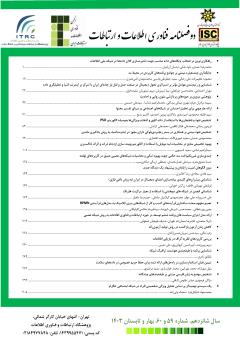ارائه راهكار نوين جهت انتخاب پايگاههاي داده مناسب برای ذخيرهسازي کلان دادهها در خدمات شبکه ملی اطلاعات
محورهای موضوعی : فناوری اطلاعات و ارتباطاتمحمد رضا احمدی 1 , داود ملکی 2 , احسان آریانیان 3
1 - هیئت علمی
2 - کارشناس مهندسی نرم افزار
3 - پژوهشگاه ارتباطات و فناوری اطلاعات
کلید واژه: کلان دادهها, پايگاههاي داده سنتي, پايگاههاي داده مدرن, شبكه ملي اطلاعات,
چکیده مقاله :
توسعه روزافزون ابزارهاي مولد خدمات دادهاي و لزوم ذخيرهسازي نتايج پردازشهاي بزرگ وگسترده حاصل از فعاليتهاي مختلف در خدمات شبکه ملی اطلاعات و دادههای تولیدی بخش خصوصي و شبكههاي فراگير اجتماعي، روند مهاجرت به پايگاههاي نوين با ويژگيهاي مناسب را اجتناب ناپذير كرده است. با گسترش و تغيير حجم و تركيب دادهها و شكلگيري کلان دادهها، عملكردها و الگوهاي سنتي پاسخگوي نيازهاي جديد نيستند. بنابراين لزوم استفاده از سيستمهاي ذخيرهسازي اطلاعات در قالبها و مدلهاي نوین و مقیاسپذیر را ضروري ساخته است. در اين مقاله راهكارهاي اساسي در خصوص ابعاد ساختاري و كاركردهاي مختلف پايگاههاي داده سنتي و سيستمهاي ذخيرهسازي نوين بررسي گرديده و راهكارهاي فني جهت مهاجرت از پايگاههاي داده سنتي به نوین و مناسب برای کلان دادهها ارائه ميگردد. همچنین، ويژگيهاي اساسي در خصوص پيوند پايگاههاي داده سنتي و نوين جهت ذخيره و پردازش دادههاي حاصل از خدمات فراگير شبکه ملی اطلاعات ارائه شده و پارامترها و قابليتهای پايگاههای داده در بستر استاندارد و هدوپ بررسی شده است. علاوه بر آن، به عنوان یک نمونه عملیاتی یک راهکار ترکیب پایگاه داده سنتی و نوین با استفاده از روش BSC ارائه شده و مورد ارزیابی و مقایسه قرار گرفته است و نشان داده شده است كه در مجموعه دادههای مختلف با حجم دادههای متفاوت، استفاده ترکيبی از هر دو نوع پايگاه هاي داده سنتي و نوين مي تواند بيشترين کارايی را به همراه داشته باشد.
The increasing development of tools producing data in different services and the need to store the results of large-scale processing results produced from various activities in the national information network services and also the data produced by the private sector and social networks, has made the migration to new databases solutions with appropriate features inevitable. With the expansion and change in the size and composition of data and the formation of big data, traditional practices and patterns do not meet new requirements. Therefore, the necessity of using information storage systems in new and scalable formats and models has become necessary. In this paper, the basic structural dimensions and different functions of both traditional databases and modern storage systems are reviewed and a new technical solution for migrating from traditional databases to modern databases is presented. Also, the basic features regarding the connection of traditional and modern databases for storing and processing data obtained from the comprehensive services of the national information network are presented and the parameters and capabilities of databases in the standard and Hadoop context are examined. In addition, as a practical example, a solution for combining traditional and modern databases has been presented, evaluated and compared using the BSC method. Moreover, it is shown that in different data sets with different data volumes, a combined use of both traditional and modern databases can be the most efficient solution.
1. Poltavtseva, Maria A. "Evolution of data management systems and their security." 2019 International Conference on Engineering Technologies and Computer Science (EnT). IEEE, 2019.
2. Gupta, Adity, et al. "NoSQL databases: Critical analysis and comparison." 2017 International Conference on Computing and Communication Technologies for Smart Nation (IC3TSN). IEEE, 2017.
3. Khasawneh, Tariq N., Mahmoud H. AL-Sahlee, and Ali A. Safia. "SQL, NewSQL, and NOSQL databases: a comparative survey." 2020 11th International Conference on Information and Communication Systems (ICICS). IEEE, 2020.
4. Harrington, Jan L. Relational database design and implementation. Morgan Kaufmann, 2016. www.bayanbox.ir/id/1046850354031105527?download.
5. Date, Chris J. Database in depth: relational theory for practitioners. " O'Reilly Media, Inc.", 2005.
6. Adhikari, M., and S. Kar. "NoSQL databases, Handbook of Research on Securing Cloud-Based Databases with Biometric Applications (2014)."
7. Murugan, P. and A. Sentraya, A Study of NoSQL and NewSQL databases for data aggregation on Big Data. 2013.
8. Maricic, M., et al. "Measuring the ict development: The fusion of biased and objective approach." Scientific Bulletin" Mircea cel Batran" Naval Academy 18.2 (2015): 326.
9. Jain, Niraja, B. Raghu, and V. Khanna. "Query Optimization for Cloud Database." 2021 6th International Conference for Convergence in Technology (I2CT). IEEE, 2021.
10. Arora, I. and A. Gupta, Cloud Databases: A Paradigm Shift in Databases. International J. of Computer Science Issues, 2012. 9(4): p. 77-83.
11. Wang, Jin, et al. "Big data service architecture: a survey." Journal of Internet Technology 21.2 (2020): 393-405.
12. NIST Big Data Public Working Group. NIST Big Data Interoperability Framework: Volume 4, Security and Privacy Version 1. No. NIST Special Publication (SP) 1500-4 (Withdrawn). National Institute of Standards and Technology, 2015.
13. Chao, Lee. Cloud database development and management. Crc Press, 2013..
14. Sakr, S., et al., A survey of large scale data management approaches in cloud environments. Communications Surveys & Tutorials, IEEE, 2011. 13(3): p. 311-336.
15. Brian Holcomb, NoSQL Database in the Cloud: Riak on AWS, Amazon Web Services, June 2013.
16. Strauch, S., V. Andrikopoulos, and T. Bachmann. Migrating application data to the cloud using cloud data. in e 3rd International Conference on Cloud Computing and Service Science,(CLOSER). 2013. Citeseer.
17. Strauch, S., et al. Decision Support for the Migration of the Application Database Layer to the Cloud. in Cloud Computing Technology and Science (CloudCom), 2013 IEEE 5th International Conference on. 2013. IEEE.
18. Oliveira, Cidália, et al. "Using the Balanced Scorecard for strategic communication and performance management." Strategic corporate communication in the digital age. Emerald Publishing Limited, 2021.
19. "2GC Balanced Scorecard Usage Survey". 2GC Active Management. Archived from the original on 1 May 2014. Retrieved 28 May 2014.


